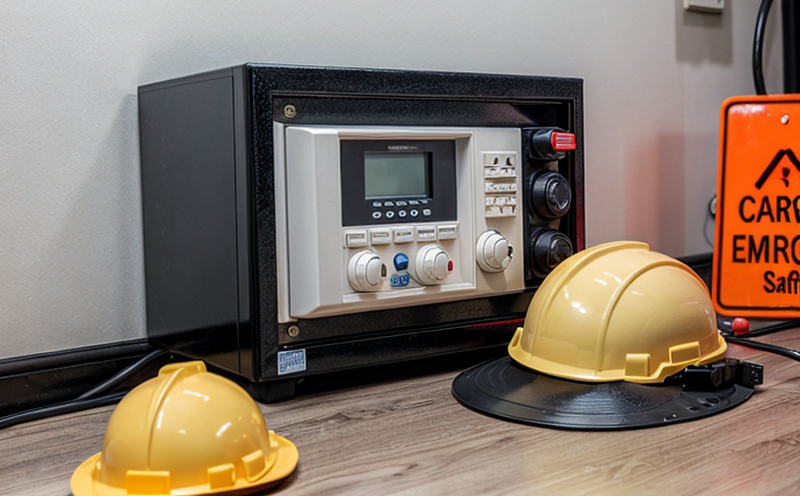FAA AC 25.813 Emergency Exit Door Testing
The Federal Aviation Administration (FAA) Advisory Circular AC 25.813 specifies stringent requirements and procedures for the testing of emergency exit doors in commercial aircraft. This service ensures compliance with these regulations to safeguard passengers and crew during emergencies. The testing covers a variety of critical aspects including structural integrity, operability, water resistance, and fire resistance.
Compliance with FAA AC 25.813 is crucial for manufacturers looking to ensure their products meet the highest safety standards set by aviation authorities globally. This service involves thorough testing that simulates real-world conditions an aircraft might encounter during a critical situation. Our laboratory uses state-of-the-art equipment and follows internationally recognized standards, such as ISO 9001:2015, to ensure accuracy and reliability.
Testing begins with the preparation of the specimen, which includes ensuring that all components are in optimal condition for testing. This process involves cleaning, inspecting, and verifying the integrity of the door assembly before any tests are conducted. The first step in the test procedure is the visual inspection followed by a thorough examination using non-destructive testing methods like radiography or ultrasonic testing to detect internal flaws.
The next phase entails structural strength testing where various loads are applied to simulate different stresses that an emergency exit door might face during an evacuation scenario. This includes static load tests, fatigue tests, and dynamic force impact tests. These tests assess the durability of the materials used in constructing the doors and their ability to withstand high stress without failure.
Operability testing is another crucial aspect as it ensures that all mechanisms operate smoothly under adverse conditions. This involves checking hinges, locks, windows, and other components for proper function. Water resistance tests are conducted by exposing the door assembly to simulated rain or spray to ensure it can prevent water ingress during a storm.
Fire resistance testing simulates exposure to high temperatures typical in an aircraft cabin fire scenario. The goal is to confirm that the materials used do not catch fire easily and maintain structural integrity even when exposed to extreme heat conditions specified by the standard.
In addition to these physical tests, we also perform environmental assessments which contribute significantly towards sustainability efforts within our sector. By reducing material waste through precise cutting and efficient use of resources during manufacturing processes, we help airlines achieve their corporate social responsibility goals while maintaining strict regulatory compliance.
- Reduction in raw material consumption
- Minimized energy usage during production phases
- Lower emissions from transportation logistics due to optimized shipping requirements
- Eco-friendly disposal practices for non-recyclable waste generated post-testing
The results of these tests are meticulously documented and presented in comprehensive reports. These reports serve as a crucial tool for manufacturers to understand their product performance relative to industry standards, aiding continuous improvement efforts. For R&D engineers, this information provides insights into potential improvements that could enhance safety features without compromising structural integrity.
Competitive Advantage and Market Impact
By offering FAA AC 25.813 Emergency Exit Door Testing services, our laboratory provides a significant competitive edge by ensuring complete compliance with regulatory requirements. This not only enhances market credibility but also promotes trust among stakeholders including customers, investors, and the general public.
In today’s highly regulated environment, meeting stringent safety standards is essential for maintaining brand reputation and operational efficiency. Our service helps manufacturers stay ahead of competitors who may not prioritize such rigorous testing protocols. It allows them to present robust evidence of their commitment to passenger safety, which can be a decisive factor in winning contracts or securing new business opportunities.
Moreover, by adhering strictly to international standards like ISO 9001:2015 and ISO/IEC 17025:2017, we position ourselves as leaders in the field of aerospace & aviation testing. This recognition fosters long-term relationships with clients, enhancing our reputation within the industry.
Use Cases and Application Examples
The FAA AC 25.813 Emergency Exit Door Testing service finds application across various scenarios in the aerospace & aviation sector:
- New Aircraft Model Development: During the early stages of aircraft design, this testing helps refine prototypes ensuring they meet all required safety standards before mass production.
- Maintenance and Repair: For ongoing maintenance activities, especially those involving replacement or modification of emergency exit doors, these tests ensure continued adherence to regulatory guidelines.
- Aircraft Retrofitting Programs: In programs where older aircraft are being upgraded with new safety features including updated emergency exits, this testing ensures all components comply with current regulations.
- Compliance Audits: Regular audits conducted by regulatory bodies often require proof of compliance. Our service provides accurate documentation needed for such inspections.
These use cases underscore the importance of our service in ensuring continuous safety standards within the aviation industry, thereby supporting its growth and development.





